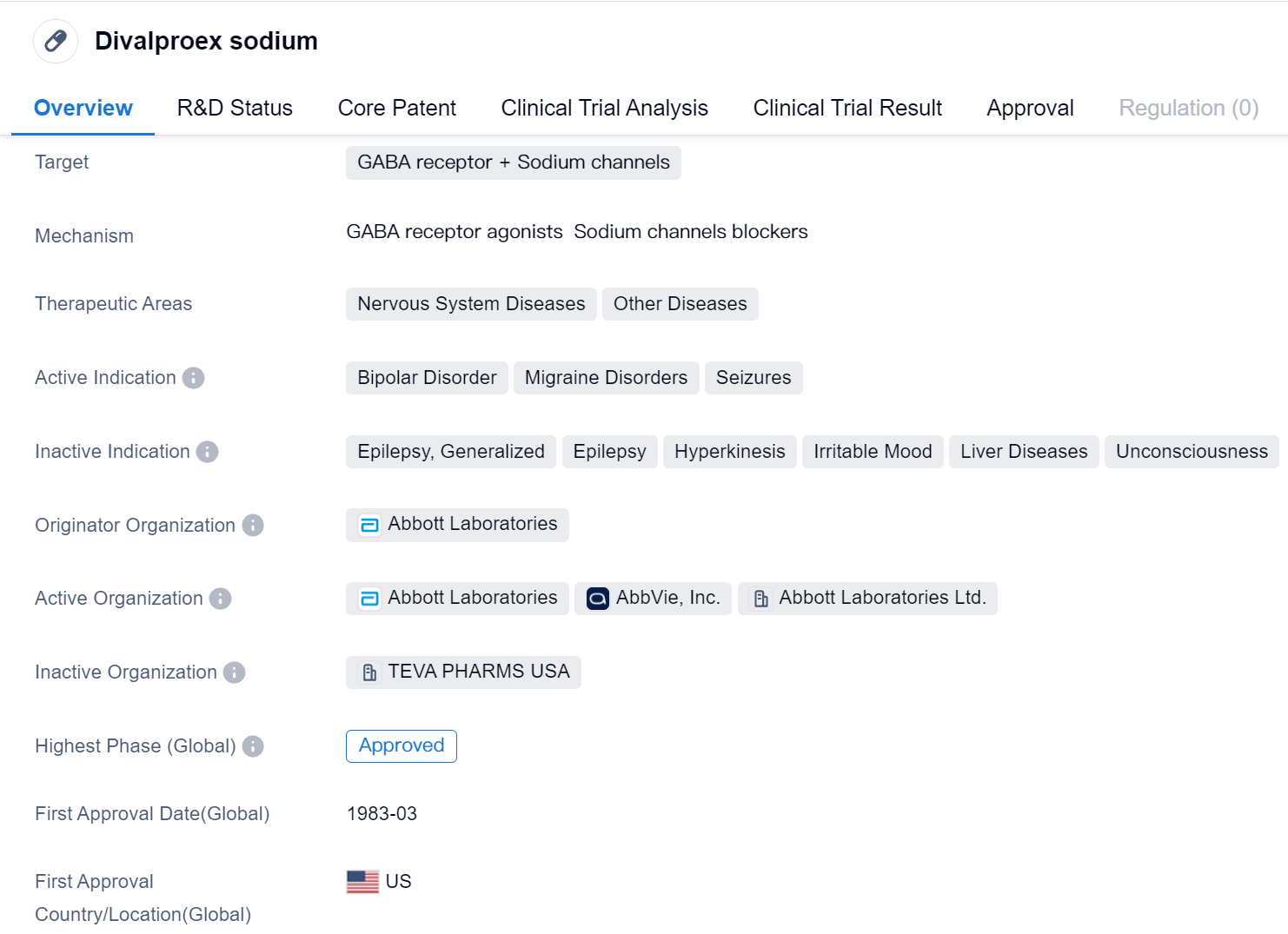An In-depth Analysis of Divalproex sodium's R&D Progress
Divalproex sodium's R&D Progress
Divalproex sodium is a small molecule drug that primarily targets the GABA receptor and sodium channels. It has been approved for use in the treatment of various nervous system diseases and other conditions. The drug's active indications include bipolar disorder, migraine disorders, and seizures.
The originator organization of Divalproex sodium is Abbott Laboratories, a well-known pharmaceutical company. The highest R&D phase of this drug is approved.
Divalproex sodium received its first approval in the United States in March 1983. This suggests that it has a long history of use and has been available to patients for several decades. The drug's approval in the United States also indicates that it has met the regulatory requirements set by the country's health authorities.
The therapeutic areas of Divalproex sodium, namely nervous system diseases and other diseases, highlight its broad potential applications beyond the specific indications mentioned. This suggests that the drug may have additional uses in treating various conditions related to the nervous system or other diseases.
👇Please click on the image below to directly access the latest data (R&D Status | Core Patent | Clinical Trial | Approval status in Global countries) of this drug.
Mechanism of Action for Divalproex sodium: GABA receptors agonists and Sodium channels blockers
GABA receptor agonists are a class of drugs that bind to and activate the gamma-aminobutyric acid (GABA) receptors in the brain. GABA is an inhibitory neurotransmitter that helps to regulate neuronal activity and promote relaxation. By enhancing GABA receptor activity, these agonists can have sedative, anxiolytic (anti-anxiety), and anticonvulsant effects. They are commonly used in the treatment of conditions such as anxiety disorders, insomnia, and epilepsy.
Sodium channel blockers, on the other hand, are a group of medications that inhibit the function of sodium channels in the body. Sodium channels play a crucial role in the generation and propagation of action potentials in nerve cells. By blocking these channels, sodium channel blockers can reduce the excitability of neurons and decrease the transmission of electrical impulses. This can be beneficial in the treatment of various conditions, including epilepsy, cardiac arrhythmias, and neuropathic pain.
It's important to note that GABA receptor agonists and sodium channel blockers are two distinct classes of drugs with different mechanisms of action. GABA receptor agonists primarily target the GABA receptors in the brain, while sodium channel blockers act on sodium channels found throughout the body.
Drug Target R&D Trends for Divalproex sodium
GABA receptors and Sodium channels play crucial roles in the human body. GABA receptors are protein structures found in the central nervous system that bind to the neurotransmitter gamma-aminobutyric acid (GABA). Activation of GABA receptors inhibits neuronal activity, resulting in a calming effect and regulation of anxiety, sleep, and muscle tone. Sodium channels, on the other hand, are integral membrane proteins that allow the flow of sodium ions across cell membranes. They are essential for the generation and propagation of action potentials in nerve cells, enabling communication between neurons and muscle cells. Dysfunction of GABA receptors or sodium channels can lead to various neurological disorders and imbalances in the body.
According to Patsnap Synapse, as of 7 Sep 2023, there are a total of 3 GABA receptor + Sodium channels drugs worldwide, from 6 organizations, covering 11 indications, and conducting 140 clinical trials.
👇Please click on the picture link below for free registration or log in directly if you have a freemium account, you can browse the latest research progress on drugs, indications, organizations, clinical trials, clinical results, and drug patents related to this target
Conclusion
Overall, Divalproex sodium is a small molecule drug that targets the GABA receptor and sodium channels. It has been approved for the treatment of bipolar disorder, migraine disorders, and seizures. The drug was developed by Abbott Laboratories and received its first approval in the United States in 1983. Its approval status and therapeutic areas indicate its potential as a treatment option for various nervous system diseases and other conditions.






